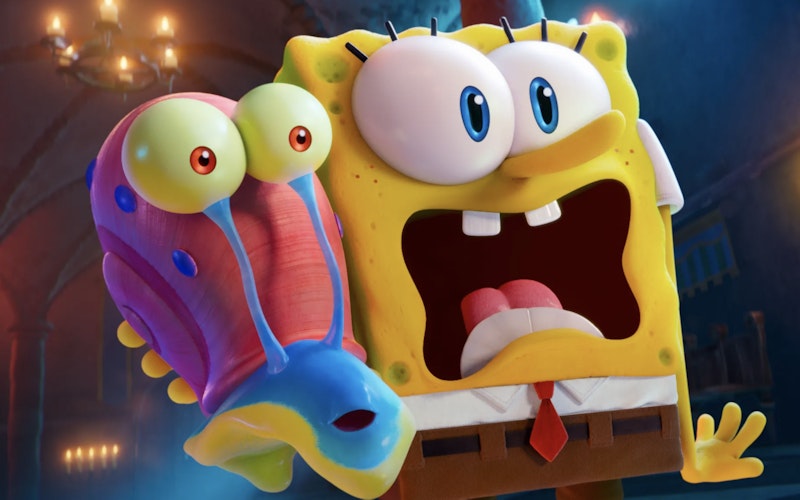
Movies
SpongeBob as Holy Fool
After much anticipation and Internet consternation, a hotly debated movie finally arrived last month. Despite disappointment with the super-heroics in the franchise's previous entry, fans signed up in droves for the new streaming service that promised all-new adventures of the characters they loved. And these fans were not disappointed. The film offers an epic tale of gods and kings and prophecies, in which a league of justice forms to thwart evildoers of untold power and restore peace to the land.
I refer, of course, to The SpongeBob Movie: Sponge on the Run.
Written and directed by Tim Hill, Sponge on the Run finds the idyllic life of SpongeBob SquarePants (Tom Kenney) and Patrick Star (Bill Fagerbakke) interrupted when the scheming Plankton (Mr. Lawrence) kidnaps SpongeBob’s beloved pet snail Gary and delivers him to the vain King Poseidon (Matt Berry). In their quest to rescue Gary, SpongeBob and Patrick encounter a malfunctioning robot called Otto (Awkwafina) and a wise sage named Sage who lives in a brush of sage, played by (who else?) Keanu Reeves.
Even if you’ve never seen an episode of the long-running SpongeBob SquarePants cartoon series, that description should make it abundantly clear that Sponge on the Run is a seriously silly movie. The film devotes a full 40 seconds of screen time to SpongeBob and Patrick bellowing “Good morning” at each other, much to the annoyance of their neighbor Squidward (Rodger Bumpass). Later, the movie introduces dramatic tension when SpongeBob and Patrick swear that they’ll never fight and break up over a misunderstanding, only to have a fight and break up over a misunderstanding, and then come back together again and finish the cliché cycle all in the span of 90 seconds.
The movie’s unwavering commitment to silliness contrasts with the serious power brokers at work in its underwater setting. Within SpongeBob’s hometown of Bikini Bottom, the yellow and porous and absorbent hero gets caught in a struggle between competing businessmen Mr. Krabs (Clancy Brown) and Plankton, both of whom need SpongeBob to keep making money. For his part, Poseidon assigns his armies to detain Gary the snail, whose slime serves as a skin cream that keeps the sovereign looking young.
When SpongeBob and Patrick finally reach Poseidon’s casino stronghold in the Lost City of Atlantic City, their bumbling gives them a literal audience with the king on the stage of his variety show. The duo reacts to the realization with the best reverence they can muster, SpongeBob giving a solemn bow while Patrick pulls up the sides of his shorts to curtsy. But the king is not pleased, and the camera pushes slowly in on his garish golden throne, where he waits impatiently.
For a single beat, it appears that SpongeBob and Patrick understand their dire circumstances. Fear freezes them on the stage, their eyes wide and their mouths agape. But after a second, the two break into a goofy ditty, complete with patty-cake slaps and armpit farts. However, SpongeBob can’t even keep his attention focused long enough to finish the song. As soon as he sees Poseidon smothering his face with Gary’s slime, SpongeBob and Patrick leap off the stage and scurry through the dining area, splashing soup and spaghetti on passing patrons, to climb up to Poseidon’s throne.
Sponge on the Run is a seriously silly movie.
In his single-minded desire to restore his friends, SpongeBob acts like a “holy fool.” According to the Russian Orthodox tradition, a holy fool is a Christian who intentionally and spectacularly contradicts the mainstream culture. In her essay “Holy Foolishness as a Key to Russian Culture,” Priscilla Hunt explains that holy fools follow Paul’s teaching from 1 Corinthians 1: “God chose the foolish things of the world to shame the wise; God chose the weak things of the world to shame the strong. God chose the lowly things of this world and the despised things—and the things that are not—to nullify the things that are, so that no one may boast before him.”
According to Hunt, the holy fool “voluntarily lives out the behavior described above in order to exemplify Paul's wisdom of the Cross. . . . He or she acts for `Christ's sake’ in two senses: first, to commune in the sacrificial humility exemplified on the Cross; and second, to bring others back to Christ by confronting them with a shocking holy foolish instantiation of the Cross.”
Although the holy fool becomes a figure of ridicule, that derision can lead to repentance. The fool’s actions may be “irrational and outrageous” in the “eyes of the world,” Hunt writes, but that very outrageousness creates “a provocative scenario aimed at opening [others’] eyes to spiritual Truth.” In other words, the holy fool invites scorn from the world to illustrate the world's separation from the virtues demonstrated by Christ.
In Sponge on the Run, we see the power of holy foolishness in a scene in which SpongeBob and Patrick’s silliness defeats the devil. Well, defeats El Diablo anyway, the leader of a gang of flesh-eating zombie pirate cowboys played by Danny Trejo. Even though the magic coin Sage gave our heroes fails to block El Diablo’s flaming laser eyes and burning knife, SpongeBob and Patrick defeat the villain by simply admiring the curtains in his lair. Every time they touch a curtain to feel its velvety smoothness, they let in a beam of light that causes El Diablo to disintegrate like a vampire. Even when their lives are being threatened by an embodiment of otherworldly evil, SpongeBob and Patrick make room for foolishness, and that foolishness saves the day.
These moments of silliness remind us that the powers and principalities of the world—whether they be gods or kings, restaurateurs or flesh-eating zombie pirate cowboy leaders—are ridiculously, laughably, foolishly insignificant compared to the power and glory of Christ.
Topics: Movies